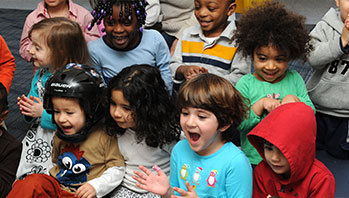- alone
- together
MA Standards:
Speaking and Listening/SL.PK.MA.1a: Observe and use appropriate ways of interacting in a group (e.g., taking turns in talking, listening to peers, waiting to speak until another person is finished talking, asking questions and waiting for an answer, gaining the floor in appropriate ways).
Head Start Outcomes:
Social Emotional Development/Self-Regulation: Follows simple rules, routines, and directions.
Language Development/Receptive Language: Attends to language during conversations, songs, stories, or other learning experiences.
PreK Learning Guidelines:
English Language Arts/Language 1: Observe and use appropriate ways of interacting in a group (taking turns in talking; listening to peers; waiting until someone is finished; asking questions and waiting for an answer; gaining the floor in appropriate ways).
English Language Arts/Reading and Literature 12: Listen to, recite, sing, and dramatize a variety of age-appropriate literature.
Greeting Song: “The More We Get Together” #1

© Commonwealth of Massachusetts, Department of Early Education and Care (Jennifer Waddell photographer). All rights reserved.
ELA Focus Skills: Follow Directions, Speaking and Listening, Vocabulary
Have children sit in a circle. Tell children you are going to sing them a song to them once and the next time you want them to sing along with you.
Sing the first two verses of “The More We Get Together.” Repeat the first two lines in the third verse as you point to each child until you sing every child’s name.
Talk about the lyrics and help children gain an understanding of the words alone and together. Say,
- When I sing the song alone, I sing all by myself. When I sing the song with all of you, we all sing together.
- Tell children you are going to sing the first verse alone and then everyone joins in to sing together the other verses together.
The More We Get Together
(sung to the tune of “Have You Ever Seen a Lassie?”)
The more we get together,
Together, together.
The more we get together,
The happier we’ll be.
For your friends are my friends,
And my friends are your friends.
The more we get together,
The happier we’ll be.
Here’s <child’s name> and <child’s name>,
And <child’s name> and <child’s name>,
Here’s <child’s name> and <child’s name>,
And <child’s name> and <child’s name>.
The more we get together,
The happier we’ll be.
Take It Further: Talk with children about opposites—two things that are totally different from each other. Remind children that you climb up a slide, and then slide down. Say, Up and down are opposites. Use your hands to demonstrate locations and ask, Who knows the opposite of over? (place hand over a chair) Yes, it is under. (place hand under chair) Over and under are opposites. Who knows another set of opposites? Let children suggest words. Correct any misconceptions.
English Language Learners: To clarify the concept of opposites, have pictures of opposites for children to see. Choose one and say, This tree is tall. Is the tree beside it tall? Give yes/no questions to help children at first. Then help them generate the opposite term by giving them the sentence frame. Say, This tree is tall. This tree is . Repeat with other pictures.
Adaptation: Simplify for very young children by singing one line at a time, then asking them to repeat it.
